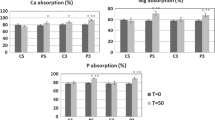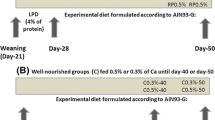Abstract
Higher calcium (Ca) absorption would partially compensate for Ca intake below requirements for bone health. Previously, we found that GOS/FOS prebiotic mixture (PM) increases Ca absorption in the colon and retention in bone. Ca absorption and retention are regulated by vitamin D (VD). Hence, it is relevant to explore whether VD insufficiency influences the effect of the PM in the colon. The effect of the PM on Ca, phosphate (IP), and magnesium (Mg) absorption and retention under conditions of VD sufficiency and insufficiency (VDInsuff) was compared using a preclinical model of VDInsuff and low bone mass. Ovariectomized rats were fed isocaloric semisynthetic diets according to AIN-93 M. The diets varied in Ca (0.5% or 0.3%), VD [100 IU% (+ D) or 0 IU% (− D)], and PM (2.5% or 0%) content. The following eight groups were studied: + D0.5; + D0.3; + DPM0.5; + DPM0.3; − D0.5; − D0.3; − DPM0.5; and − DPM0.3. Irrespective of Ca content, VDInsuff did not affect the prebiotic effect of the PM on caecum pH, lactobacillus colony growth, or Mg absorption but significantly decreased its effect on colonic crypt length and cell/crypt and Ca and IP absorption. The PM failed to counterbalance the pro-inflammatory effect of VDInsuff. Moreover, bone retention i.e., bone mineral content and density, bone volume, and bone quality parameters were significantly lower (p < 0.05) and bone turnover significantly was higher (p < 0.05). Although the PM is a useful tool to improve mineral absorption and bone retention, it would seem important to monitor VD nutritional status to ensure the full prebiotic effect in the large intestine.




Similar content being viewed by others
References
Rizzoli R (2018) Postmenopausal osteoporosis: assessment and management. Best Pract Res Clin Endocrinol Metab 32:739–757. https://doi.org/10.1016/j.beem.2018.09.005
Quann EE, Fulgoni VL, Auestad N (2015) Consuming the daily recommended amounts of dairy products would reduce the prevalence of inadequate micronutrient intakes in the United States: diet modeling study based on NHANES 2007–2010. Nutr J 14:1–11. https://doi.org/10.1186/s12937-015-0057-5
Ilesanmi-Oyelere BL, Brough L, Coad J et al (2019) The relationship between nutrient patterns and bone mineral density in postmenopausal women. Nutrients 11:1262. https://doi.org/10.3390/nu11061262
Roberfroid MB (2002) Functional foods: concepts and application to inulin and oligofructose. Br J Nutr 87:S139–S143. https://doi.org/10.1079/BJN/2002529
Wallace TC, Marzorati M, Spence L et al (2017) New frontiers in fibers: innovative and emerging research on the gut microbiome and bone health. J Am Coll Nutr 36:218–222. https://doi.org/10.1080/07315724.2016.1257961
Whisner CM, Castillo LF (2018) Prebiotics, bone and mineral metabolism. Calcif Tissue Int 102:443–479. https://doi.org/10.1007/s00223-017-0339-3
Macfarlane S, Macfarlane GT, Cummings JH (2006) Prebiotics in the gastrointestinal tract. Aliment Pharmacol Ther 24:701–714. https://doi.org/10.1016/B978-0-12-374938-3.00010-4
Karbach U, Feldmeier H (1993) The cecum is the site with the highest calcium absorption in rat intestine. Dig Dis Sci 38:1815–1824. https://doi.org/10.1007/BF01296104
Bouillon R, Van Cromphaut S, Carmeliet G (2003) Intestinal calcium absorption: molecular vitamin D mediated mechanisms. J Cell Biochem 88:332–339. https://doi.org/10.1002/jcb.10360
Khazai N, Judd SE, Tangpricha V (2008) Calcium and vitamin D: skeletal and extraskeletal health. Curr Rheumatol Rep 10:110–117. https://doi.org/10.1007/s11926-008-0020-y
Cantorna MT, McDaniel K, Bora S et al (2014) Vitamin D, immune regulation, the microbiota, and inflammatory bowel disease. Exp Biol Med 239:1524–1530. https://doi.org/10.1177/1535370214523890
Nie X, Jin H, Wen G et al (2020) Estrogen regulates duodenal calcium absorption through differential role of estrogen receptor on calcium transport proteins. Dig Dis Sci 65:3502–3513. https://doi.org/10.1007/s10620-020-06076-x
Van Cromphaut SJ, Rummens K, Stockmans I et al (2003) Intestinal calcium transporter genes are upregulated by estrogens and the reproductive cycle through vitamin D receptor-independent mechanisms. J Bone Miner Res 18:1725–1736. https://doi.org/10.1359/jbmr.2003.18.10.1725
Wronski TJ, Lowry PL, Walsh CC, Ignaszewski LA (1985) Skeletal alterations in ovariectomized rats. Calcif Tissue Int 37:324–328. https://doi.org/10.1007/BF02554882
Seijo M, Bryk G, Coronel MZ et al (2019) Effect of adding a galacto-oligosaccharides/fructo-oligosaccharides (GOS/FOS®) mixture to a normal and low calcium diet, on calcium absorption and bone health in ovariectomy-induced osteopenic rats. Calcif Tissue Int 104:301–312. https://doi.org/10.1007/s00223-018-0490-5
Bryk G, Coronel MZ, Pellegrini G et al (2015) Effect of a combination GOS/FOS® prebiotic mixture and interaction with calcium intake on mineral absorption and bone parameters in growing rats. Eur J Nutr 54:913–923. https://doi.org/10.1007/s00394-014-0768-y
Parfitt AM (1988) Bone histomorphometry: standardization of nomenclature, symbols and units (summary of proposed system). Bone 9:67–69. https://doi.org/10.1016/8756-3282(88)90029-4
Collins TJ (2007) ImageJ for microscopy. Biotechniques 43:S25–S30. https://doi.org/10.2144/000112517
Ricci M (2015) Laboratory animal control diets: very important, often neglected. Lab Anim 44:240
Gamboa Márquez A, Garzón-Alvarado DA (2011) Factores mecánicos en enfermedades osteocondrales. Rev Cuba Investig Bioméd 30:171–192. https://doi.org/10.35537/10915/28947
Nilsson O, Marino R, De Luca F et al (2005) Endocrine regulation of the growth plate. Horm Res Paediatr 64:157–165. https://doi.org/10.1159/000088791
Schwartz Z, Schlader DL, Ramirez V et al (1989) Effects of vitamin D metabolites on collagen production and cell proliferation of growth zone and resting zone cartilage cells in vitro. J Bone Miner Res 4:199–207. https://doi.org/10.1002/jbmr.5650040211
Ilesanmi-Oyelere BL, Kruger MC (2020) The role of milk components, pro-, pre-, and synbiotic foods in calcium absorption and bone health maintenance. Front Nutr. https://doi.org/10.3389/fnut.2020.578702
Drozdowski L, Thomson AB (2006) Intestinal mucosal adaptation. World J Gastroenterol WJG 12:4614. https://doi.org/10.3748/wjg.v12.i29.4614
Sun J (2010) Vitamin D and mucosal immune function. Curr Opin Gastroenterol 26:591. https://doi.org/10.1097/MOG.0b013e32833d4b9f
Tabatabaeizadeh S-A, Tafazoli N, Ferns GA et al (2018) Vitamin D, the gut microbiome and inflammatory bowel disease. J Res Med Sci 23:75. https://doi.org/10.4103/jrms.JRMS_606_17
Akimbekov NS, Digel I, Sherelkhan DK et al (2020) Vitamin D and the host-gut microbiome: a brief overview. Acta Histochem Cytochem 53:33–42. https://doi.org/10.1267/ahc.20011
Kong J, Zhang Z, Musch MW et al (2008) Novel role of the vitamin D receptor in maintaining the integrity of the intestinal mucosal barrier. Am J Physiol-Gastrointest Liver Physiol 294:G208–G216. https://doi.org/10.1152/ajpgi.00398.2007
Chatterjee I, Lu R, Zhang Y et al (2020) Vitamin D receptor promotes healthy microbial metabolites and microbiome. Sci Rep 10:1–18. https://doi.org/10.1038/s41598-020-64226-7
Yamamoto EA, Jørgensen TN (2020) Relationships between vitamin D, gut microbiome, and systemic autoimmunity. Front Immunol 10:3141. https://doi.org/10.3389/fimmu.2019.03141
Swaggerty CL, Callaway TR, Kogut MH et al (2019) Modulation of the immune response to improve health and reduce foodborne pathogens in poultry. Microorganisms 7:65. https://doi.org/10.3390/microorganisms7030065
Tang L, Cheng CY, Sun X et al (2016) The extracellular calcium-sensing receptor in the intestine: evidence for regulation of colonic absorption, secretion, motility, and immunity. Front Physiol 7:245. https://doi.org/10.3389/fphys.2016.00245
Rizzoli R (2019) Nutritional influence on bone: role of gut microbiota. Aging Clin Exp Res 31:743–751. https://doi.org/10.1007/s40520-019-01131-8
Tjellström B, Stenhammar L, Högberg L, Fälth-Magnusson K, Magnusson KE, Midtvedt T, Sundqvist T, Norin E (2005) Gut microflora associated characteristics in children with celiac disease. Am J Gastroenterol 100:2784–2788. https://doi.org/10.1111/j.1572-0241.2005.00313.x
Conlon MA, Bird AR (2015) The impact of diet and lifestyle on gut microbiota and human health. Nutrients 7:17–44. https://doi.org/10.3390/nu7010017
Battistini C, Nassani N, Saad SM, Sun J (2020) Probiotics, vitamin D, and vitamin D receptor in health and disease. Lactic acid bacteria: a functional approach. CRC Press, Boca Raton, pp 93–105
Singh P, Rawat A, Alwakeel M et al (2020) The potential role of vitamin D supplementation as a gut microbiota modifier in healthy individuals. Sci Rep 10:1–14. https://doi.org/10.1038/s41598-020-77806-4
Guida F, Boccella S, Belardo C et al (2020) Altered gut microbiota and endocannabinoid system tone in vitamin D deficiency-mediated chronic pain. Brain Behav Immun 85:128–141. https://doi.org/10.1016/j.bbi.2019.04.006
Shang M, Sun J (2017) Vitamin D/VDR, probiotics, and gastrointestinal diseases. Curr Med Chem 24:876–887. https://doi.org/10.2174/0929867323666161202150008
Hernandez CJ, Beaupre GS, Carter DR (2003) A theoretical analysis of the relative influences of peak BMD, age-related bone loss and menopause on the development of osteoporosis. Osteoporos Int 14:843–847. https://doi.org/10.1007/s00198-003-1454-8
Dhawan P, Veldurthy V, Yehia G et al (2017) Transgenic expression of the vitamin D receptor restricted to the ileum, cecum, and colon of vitamin D receptor knockout mice rescues vitamin D receptor-dependent rickets. Endocrinology 158:3792–3804. https://doi.org/10.1210/en.2017-00258
Grinstead WC, Pak CY, Krejs GJ (1984) Effect of 1,25−dihydroxyvitamin D3 on calcium absorption in the colon of healthy humans. Am J Physiol-Gastrointest Liver Physiol 247:G189–G192. https://doi.org/10.1152/ajpgi.1984.247.2.G189
Yousefzadeh N, Kashfi K, Jeddi S, Ghasemi A (2020) Ovariectomized rat model of osteoporosis: a practical guide. EXCLI J 19:89. https://doi.org/10.17179/excli2019-1990
Lips P (2001) Vitamin D deficiency and secondary hyperparathyroidism in the elderly: consequences for bone loss and fractures and therapeutic implications. Endocr Rev 22:477–501. https://doi.org/10.1210/edrv.22.4.0437
Abboud M, Rizk R, AlAnouti F et al (2021) The health effects of vitamin D and probiotic co-supplementation: a systematic review of randomized controlled trials. Nutrients 13:111. https://doi.org/10.3390/nu13010111
Acknowledgements
The authors thank technicians Ricardo Orzuza and Julia Somoza for their technical assistance. The present study was supported by Grants of Buenos Aires University (UBACyT 20020170100011BA) and CONICET (PIP 11220130100199CO).
Author information
Authors and Affiliations
Contributions
Author SNZ and PMPML designed the study and prepared the first draft of the paper. SNZ is guarantor. Authors SM, BMS, BG, and ZCM contributed to the experimental work. Author SM was responsible for statistical analysis of the data. All authors revised the paper critically for intellectual content and approved the final version. All authors agree to be accountable for the work and to ensure that any questions relating to the accuracy and integrity of the paper are investigated and properly resolved.
Corresponding author
Ethics declarations
Conflict of interest
Seijo Mariana, Bonanno Marina Soledad, Bryk Gabriel, Zeni Coronel Magalí, Pita Martín de Portela María Luz, and Zeni Susana Noemí declares have no relevant financial or non-financial interests to disclose.
Human and Animal Rights
Experimental protocol was approved by the Bioethics Committee of UBA (Resolution CS4081/04).
Informed Consent
The informed consent was obtained from all individual participants included in this study.
Additional information
Publisher's Note
Springer Nature remains neutral with regard to jurisdictional claims in published maps and institutional affiliations.
Supplementary Information
Below is the link to the electronic supplementary material.
Rights and permissions
About this article
Cite this article
Seijo, M., Bonanno, M.N., Bryk, G. et al. Does Vitamin D Insufficiency Influence Prebiotic Effect on Calcium Absorption and Bone Retention?. Calcif Tissue Int 111, 300–312 (2022). https://doi.org/10.1007/s00223-022-00984-y
Received:
Accepted:
Published:
Issue Date:
DOI: https://doi.org/10.1007/s00223-022-00984-y




